Physical Wellness Month
On Being Active in a Body Positive Way
Simaran Kalkat, UBC Medicine
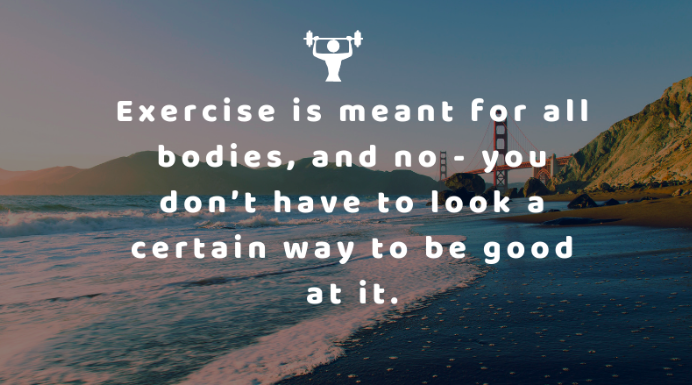
Like diet fads, there is also a ton of misleading information about exercise available to us. All forms of exercise can be beneficial to our physical health, and all body types can benefit from exercise. Being active for health looks different for everyone. For some people that’s lifting weights at the gym, and for others that’s a nice run in the fresh air. For some it’s moving your limbs on a yoga mat, and for others it’s moving your hips in a dance class. One form of exercise isn’t necessarily better than the other. If it makes you feel good, then it’s good. Even if your favourite form of exercise doesn’t make you drop a pant size or give you wash-board abs, it shouldn’t hold you back from doing it. While weight loss or muscle building can be healthy goals if done right, we should still be mindful of where our goals come from.
Exercise is an amazing way to promote health. However, the reality is that exercise, like diet, is often used as a tool to promote weight loss, muscle toning, or some other form of changing our appearance. While that isn’t necessarily a bad thing, it’s important to remember that no matter your size, gender, age, education level, or socioeconomic status – no one is immune to the feelings of inadequacy or insecurity when it comes to our bodies. We become too aware of numbers on scales, waistlines and nutrition labels, and thus fall into unhealthy patterns of thinking and action. Our beliefs and goals towards exercise can start to become more about how we look rather than how we feel.
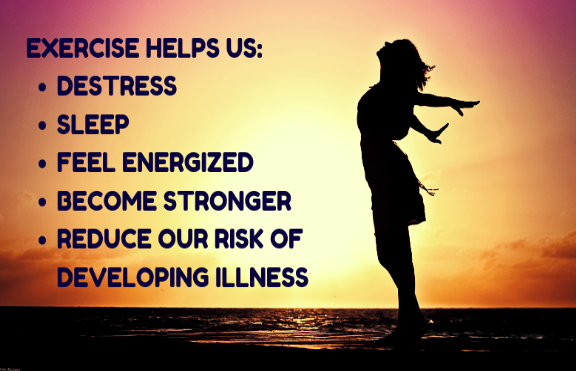
The “wellness” industry and media often portray lean and toned as the ideal body type, allowing them to profit off of our insecurities. We don’t need to adopt this “ideal image” to be healthy, and we definitely shouldn’t be doing things that make us unhappy to fit some vain idea of beauty. Rather, let’s focus on function, wellbeing and enjoyment when we’re moving our bodies. When we exercise in ways that we enjoy, we become more aware of what our bodies are capable of, and in this way even promote body positivity. However, when we try to be active with less appealing forms of exercise, we may just be promoting feelings of unworthiness or failure - especially when we struggle through those workouts or when we decide not to go back because we never liked it in the first place. Doing something you enjoy is not only more sustainable, but overall better for your mental health. But even when you’re doing something you enjoy, it’s not always easy to escape body shaming notions.
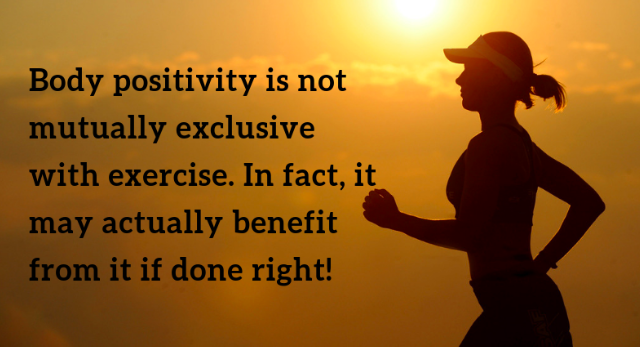
Ways to exercise and promote physical health in a body positive way:
- Focus on what your body can do rather than what your body looks like. Make your goals about how long or fast you can run, how many reps you can do, or how long you can hold a pose, rather than how much weight you can lose. However, do this without comparing yourself to others, and make your goals in small attainable steps.
- Skip the scale. Just throw it out. If it stresses you out, there’s no need for it. It is not a measure of your self-worth and is likely doing more harm than good. Health benefits can be achieved even in the absence of weight loss when we exercise, so a scale is not a necessity for health.
- Be active without expectations of what it will do to your weight or appearance. You are more than just a before and after image, and neither the before nor after body are more worthy of acceptance than the other.
- Wear comfortable clothing. Wear something that you can move in, that you don’t need to constantly readjust, and that doesn’t frequently make you feel self-conscious about your body when you exercise. Wear clothing that allows you to focus on what your body is doing, rather than what it looks like when you’re active.
- Don’t overdo it. If you enjoy the feeling of DOMS after your workout then that’s great for you. But if you don’t like that feeling, you can still have an effective workout. You don’t need to do a form a formal or intense exercise everyday to be active. Find what’s right for your body and recognize that no matter your preferences and abilities when it comes to exercise, your fitness is meant to make you feel good.
- Rethink your ideas around food and exercise. Yes, certain foods will make us feel better when we exercise and others not so much. However, exercise should never be a punishment for what you ate, and nor should it be a form of preparation for what you’re about to eat. This can resemble disordered eating behaviours. If you really are struggling with your body image, and food and exercise become sources of stress for you, then please:
- Get help. Talk to a healthcare professional (counsellor, family doctor, psychiatrist).
Mini Guide to the Gym
Kevin Karivelil, McMaster
An ideal workout depends on your goals and ability to comfortably perform each exercise in the designated workout. Workouts do not need to take more than an hour! No matter the workout, good form and consistency are key!
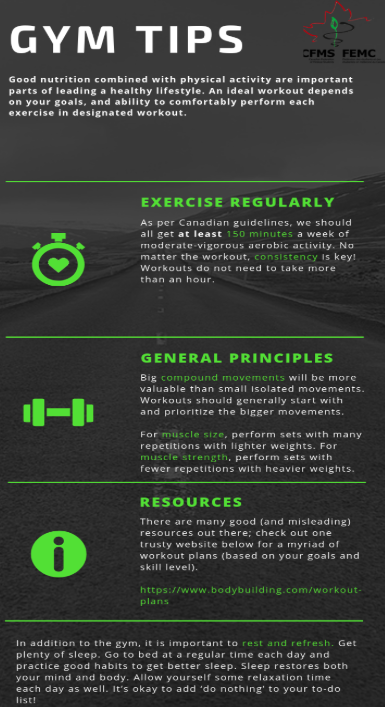
Nutrition and Exercise
Simaran Kalkat, UBC Medicine
www.eat2run.com is a great website created by a holistic sports nutritionist in Vancouver that provides nutrition advice for improving athletic performance and recovery post-exercise. It consists of many blog posts on evidence based sports related nutrition (specifically running, but applicable to other forms of physical activity as well). Check it out for recipes for pre- and post-workout, as well as foods/meals to eat to help with endurance and recovery!
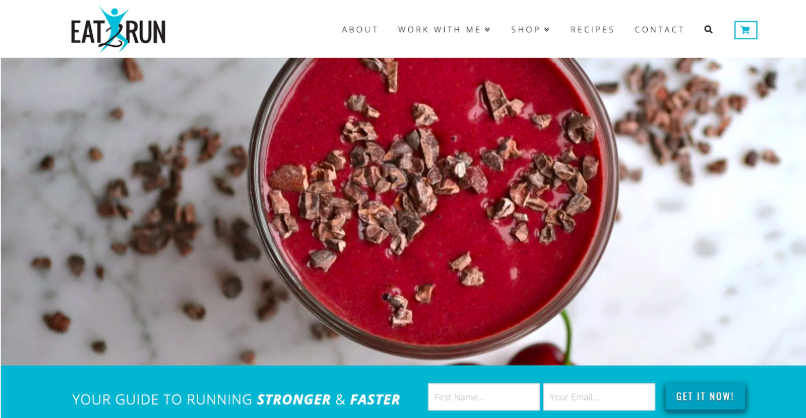
Tips and Tricks for your Next Home Workout & Pre-workout snacks
Neraj Manhas, uOttawa
Finding the time to go to the gym can be super hard when trying to manage preclerkship/clerkship and a busy study schedule. Getting physical exercise is so important for your mental and physical well-being, and it helps me concentrate and do better on exams. But I understand it can be hard to get to the gym on some days; for those days, I like to use the pomodoro technique. I do this for four cycles and then take a longer break for 30 minutes (rinse and repeat).
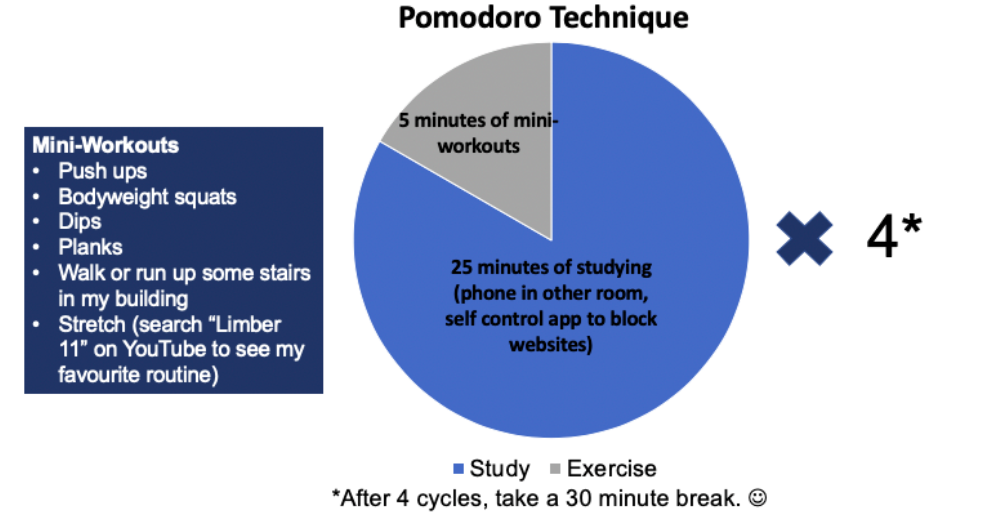
Instructions:

Other pre-workout snacks I like: Greek yogurt with granola, Overnight oats with almond milk, protein powder, natural PB, strawberries and a few dark chocolate chips,Apples or banana dipped in natural peanut butter
Hope that these tips are helpful for your next session. If you’re feeling unmotivated, sometimes making plans to go with a classmate or friend can keep you accountable and get you doing something outside of studying. Getting there can be the biggest and hardest step, and once you get there, everything else is a breeze!
Quick strategies to promote activity
Brandon Lam, uOttawa; Ryan Densmore, Dalhousie
- Instead of always taking the elevator, take the stairs! You’ll be getting a decent cardiovascular and leg workout throughout your work day.
- For all the early birds out there, try enrolling yourself into a work out class (yoga, spin, high intensity interval) to get a great start to your day. You’ll be feeling healthy, energized and ready to tackle your day. This also saves up extra time for relaxation, cooking, studying, and any other extra curricular activities. You’ll always be able to find a gym in your area that opens early with teaching classes! Note an early riser? No worries, exercises classes almost always run throughout the day and evening as well, so find a time that works for you!
- Instead of taking the shuttle bus or driving to work, why not try biking! It saves time, especially if you are in a busy metropolitan area. You also get a great cardiovascular and leg work out before you start your work day!
- Stand up more! Try studying at a standing desk, or standing on public transport, or even standing when reviewing cases or charts. It will help your muscles and joints stay a bit looser keep your blood flowing. Just make sure you have comfy shoes if you will be standing for long periods of time!
- Medical students are very busy day to day so I understand it’s hard to incorporate physical activity. Try your best to push yourself to do any amount of physical activity three to four times per week. You don’t even have to go work out in a gym, or go play a sport, you could simply walk around your neighbourhood, or do 10 push-ups and sit-ups while waiting for a pot of water to boil; if you didn’t plan on doing any physical activity on a certain day, anything is better than nothing! As long as you try and get moving, your body will thank you :)
- Everybody seems to think that to be fit you have to get a membership at the gym, that’s totally untrue! Try to pick up a sport (basketball, volleyball ,etc) and play outdoors. If you’re not into organized sports, a local playground will usually have everything you need to get some excellent body-weight exercises in! You’ll be getting a great workout while having fun at the same time!
- Find an exercise buddy with similar goal to yourself. It is much easier to keep up with your activities when there is someone who is holding you accountable or depending on you to be there with them! Plus it is great to have a friend to motivate you to be better and make a positive impact on your health and wellness :)


Importance of Sleep in Overall Wellness
Kelsie Ou, UOttawa
Why is sleep important in the first place?
- Happiness, energy, and productivity are correlated with your quality of sleep.
- Chronic sleep deprivation has been associated with an increased risk of Alzheimer’s disease.
- You are more likely to gain weight and look older with chronic sleep deprivation.
What can I do to get better sleep?
1. Make some lifestyle modifications

2. Use technology wisely!

3. Avoid doing work while sitting on your bed, otherwise your brain will associate your bed with work rather than sleep.
4. Create a bedtime routine that you are committed to following daily. This might include putting away your work 30 minutes before bed and reading, stretching, meditating, writing in a journal, etc.
5. Optimize your sleeping enviroment

Meditation apps like Calm and Headspace offer specially designed sessions for sleep.
SleepCycle will track your sleep stages throughout the night and determine the optimal time to wake you in the morning.
What to do when you can't sleep
- Do NOT stare at the clock! Lights and numbers will stimulate your brain to stay awake.
- Think about things that you are grateful for/that make you happy or calm.
- Consider getting up and doing something else if you haven’t been able to fall asleep for about 30 minutes (but avoid anything stimulating).
- Seek out a healthcare professional if you have chronic sleep difficulties. There may be a medical or psychiatric cause.
- Remember that most people have difficulty falling asleep some nights, this is normal!

